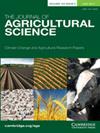白色罗苹种皮的特性研究
IF 1.7
4区 农林科学
Q2 AGRICULTURE, MULTIDISCIPLINARY
引用次数: 0
摘要
白露宾(Lupinus albus L.)是一种极具潜力的冬季豆科作物,在美国弗吉尼亚州立大学进行了多年的研究。这一努力培育出了几种耐寒、高产的品种,它们的种子中生物碱的浓度各不相同。本研究对5个罗苹品系(VSU-1、VSU-1X、VSU-5、VSU-10和VSU-101)的种子进行了多种成分特别是种皮和子叶部分的表征。每系500粒种子分成种皮和子叶,记录其相对比例。分析了整个种子、种皮和子叶,以确定蛋白质、纤维、脂肪、铁和锌的浓度。种皮比例在5个品系间差异显著,为22.6% ~ 25.6%。在种皮、子叶和整个种子中,蛋白质(7.8%、41.6%和34.3%)、纤维(44.7%、1.0%和12.2%)、脂肪(1.3%、10.4%和8.6%)和锌(14.5%、61.9%和50.8%)浓度的比例分别有显著差异,但铁浓度的差异不大。本研究结果表明,白罗苹种子种皮分离技术可用于开发高附加值产品;提高白罗苹种子的营养品质;提高了白露作为植物蛋白源的适宜性。本文章由计算机程序翻译,如有差异,请以英文原文为准。
Characterization of White Lupin Seed Coats
White lupin (Lupinus albus L.), a winter legume crop with tremendous potential as a food crop, has been evaluated at Virginia State University for several years. This effort has developed several winter-hardy, high-yielding lines, which vary in alkaloid concentration in the seeds. Current study was conducted to characterize various component of lupin seed especially seed coat and cotyledon portion in seeds of five lupin lines (VSU-1, VSU-1X, VSU-5, VSU-10, and VSU-101). Five hundred seeds of each line were separated into seed coats and cotyledons to record relative proportions. Whole seeds, seed coats, and cotyledons were analyzed to determine concentrations of protein, fiber, fat, iron and zinc. Significant differences were observed among five lines for seed coat proportion, which varied from 22.6 to 25.6 percent. Proportions of protein (7.8, 41.6, and 34.3 percent), fiber (44.7, 1.0, and 12.2 percent), fat (1.3, 10.4, and 8.6 percent), and zinc (14.5, 61.9, and 50.8 percent) concentrations varied significantly for seed coats, cotyledons, and whole seed, respectively but not for iron concentration. Results of this study indicate that separation of seed coats from white lupin seed could be used to develop value-added products; to increase nutritional quality of white lupin seeds; and enhance white lupin’s suitability as a plant protein source.
求助全文
通过发布文献求助,成功后即可免费获取论文全文。
去求助
来源期刊

Journal of Agricultural Science
农林科学-农业综合
CiteScore
2.80
自引率
5.00%
发文量
68
审稿时长
1.4 months
期刊介绍:
The Journal of Agricultural Science publishes papers concerned with the advance of agriculture and the use of land resources throughout the world. It publishes original scientific work related to strategic and applied studies in all aspects of agricultural science and exploited species, as well as reviews of scientific topics of current agricultural relevance. Specific topics of interest include (but are not confined to): all aspects of crop and animal physiology, modelling of crop and animal systems, the scientific underpinning of agronomy and husbandry, animal welfare and behaviour, soil science, plant and animal product quality, plant and animal nutrition, engineering solutions, decision support systems, land use, environmental impacts of agriculture and forestry, impacts of climate change, rural biodiversity, experimental design and statistical analysis, and the application of new analytical and study methods (including genetic diversity and molecular biology approaches). The journal also publishes book reviews and letters. Occasional themed issues are published which have recently included centenary reviews, wheat papers and modelling animal systems.
 求助内容:
求助内容: 应助结果提醒方式:
应助结果提醒方式:


